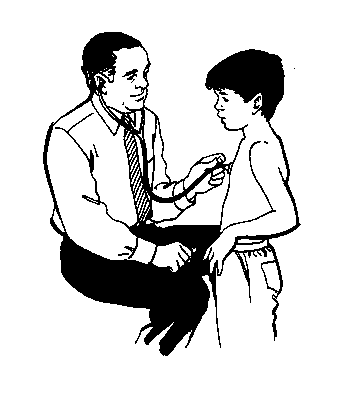LINKS:
![]() Return
to
Return
to
DoD Course
![]() TRICARE
TRICARE
Sites
![]() Group
2
Group
2
members
As a result of this and
other downsizing efforts, 35 percent of the
military hospitals that existed in the U.S. in 1987 have
closed, yet the number of people seeking health care through the MHSS has
dropped far less… by only 9 percent. Another shift
in support requirements has occurred over the last few decades.
In the 1950s, military retirees and their families comprised
only 8 percent of those eligible for care in the military
health care system."
"Because
of the rising health care costs and the closure of military bases,
the military had to develop a new way of delivering health
care to eligible beneficiaries. The Department of
Defense’s response to this challenge led to TRICARE.
"
 Introduction
Introduction
This research paper looks at TRICARE’s marketing strategies and relates them to theories studied in the Department of Defense Joint Course in Communication.
This study gathers material with the hypothesis that information passed is not reaching the beneficiaries in an understandable way, and suggests ways to improve communication between military treatment facilities and the people TRICARE serves. The purpose of this research project is to analyze the marketing efforts of the Military Health Service System’s (MHSS) TRICARE program and compare them to the Diffusion of Innovation theory (Rogers, 1983) to test whether or not the campaign on the military retirees has been successful in getting the beneficiaries to adopt the innovation of TRICARE.
The
Department of Defense is responding to the nation’s call for health care
reform with its own version of managed care, called TRICARE. This type
of health care has been moving away from a "fee-for-service"
system to a more high-quality, cost-effective managed care system. In addition,
following military downsizing with the subsequent closure of several military
installations, something had to be done to provide military retirees, in
Base Realignment and Closure Commission areas  (BRAC),
with a means to continue their health care "benefit." This project
focuses on how the TRICARE Marketing Office organizes its information and
disseminates it to its audience -- the beneficiaries. After reviewing the
various communication media used by the TRICARE Marketing Office, the authors
will use the five attributes of innovation (1) relative advantage, (2)
compatibility, (3) complexity, (4) reliability (triability), and (5) observability,
to dissect the information using the diffusion of innovations theory. The
authors judge content analysis in an unbiased and systematic way based
on their specialized public affairs knowledge, communication skills, and
status as eligible military health care beneficiaries.
(BRAC),
with a means to continue their health care "benefit." This project
focuses on how the TRICARE Marketing Office organizes its information and
disseminates it to its audience -- the beneficiaries. After reviewing the
various communication media used by the TRICARE Marketing Office, the authors
will use the five attributes of innovation (1) relative advantage, (2)
compatibility, (3) complexity, (4) reliability (triability), and (5) observability,
to dissect the information using the diffusion of innovations theory. The
authors judge content analysis in an unbiased and systematic way based
on their specialized public affairs knowledge, communication skills, and
status as eligible military health care beneficiaries.
According to the brochure, TRICARE and Your Health Care Choices (http:www.ha.osd.mil/tricare/retinfo2.html),
The Department of Defense operates one of the nation’s largest health care systems. Nearly 8.3 million individuals are eligible to receive care through the Military Health Services System. Since the end of the Cold War, the U.S. military has dealt with new challenges to its organization and mission. Fewer men and women are on active duty. Along with fewer combat forces, there have been reductions in support forces, including physicians and other medical professionals. In fact, the number of doctors, nurses and medical technicians in military service has declined as much as 50 percent in some locations. The Base Realignment and Closure Commission (BRAC) recommended closing a number of installations that were no longer needed for a smaller military force. As a result of this and other downsizing efforts, 35 percent of the military hospitals that existed in the U.S. in 1987 have closed, yet the number of people seeking health care through the MHSS has dropped far less… by only 9 percent. Another shift in support requirements has occurred over the last few decades. In the 1950s, military retirees and their families comprised only 8 percent of those eligible for care in the military health care system. Today, retirees… who usually require more medical care then their active duty counterparts, make up more than 50 percent of those eligible for care. Simply stated, the demand for health care began to exceed the systems capacity to deliver it. Two more factors led to changes in the MHSS… the rising cost of health care and the continuing requirement to maintain a trained and ready medical corps to support our troops, in peace or combat.
Because of the rising health care costs and the closure of military bases, the military had to develop a new way of delivering health care to eligible beneficiaries. The Department of Defense’s response to this challenge led to TRICARE. This plan offers beneficiaries three choices for their health care: TRICARE Standard, a fee-for-service option that is the same as CHAMPUS; TRICARE Extra, a preferred provider option that saves money over Standard; and TRICARE Prime, a Health Maintenance Organization (HMO) type care where military treatment facilities can be the principle source of health care. The biggest challenge for beneficiaries today is making a choice between these three options. In pre-TRICARE days beneficiaries had only two medical care options to choose from: treatment at a military facility or a civilian facility with CHAMPUS.
CHAMPUS
provided the uniformed health insurance coverage for military families
and retirees and their families prior to the creation of TRICARE. To add
to the confusion, some brochures state active duty members are not eligible
for TRICARE. However, they are  actually
automatically enrolled in TRICARE. By enrolling in TRICARE Prime, some
family members believe they also get the TRICARE Dental benefits; however,
this is not the case. TRICARE Dental is an entirely different program which
is operated by a different contractor using a different set of rules. Also
for the first time, military retirees under the age of 65 are required
to pay an annual or quarterly premium if they choose to participate in
TRICARE Prime. Military retirees eligible for Medicare are not allowed,
at this time, to participate in the program. This has been perceived by
many military retirees as a ‘slap in the face’ as they were led to believe
that, if they served and sacrificed until they were eligible to retire
from the military with a pension, they and their eligible dependents would
receive free medical care for life.
actually
automatically enrolled in TRICARE. By enrolling in TRICARE Prime, some
family members believe they also get the TRICARE Dental benefits; however,
this is not the case. TRICARE Dental is an entirely different program which
is operated by a different contractor using a different set of rules. Also
for the first time, military retirees under the age of 65 are required
to pay an annual or quarterly premium if they choose to participate in
TRICARE Prime. Military retirees eligible for Medicare are not allowed,
at this time, to participate in the program. This has been perceived by
many military retirees as a ‘slap in the face’ as they were led to believe
that, if they served and sacrificed until they were eligible to retire
from the military with a pension, they and their eligible dependents would
receive free medical care for life.
This research is significant in that military public affairs offices everywhere are continually challenged with disseminating information on TRICARE and its benefits. Health care benefits have been ranked near the top as one of the military’s most important quality of life issues. Military health care also has been perceived by active duty members and their families and by retired military members, as a slowly eroding benefit – a perception the military wants to eradicate. To maintain confidence in the Military Health Services System, and to contribute to the morale and retention of highly qualified military personnel, the TRICARE marketing effort must be clear enough to reach the targeted audience so members will understand their benefits and be able to make an educated choice in receiving those benefits.